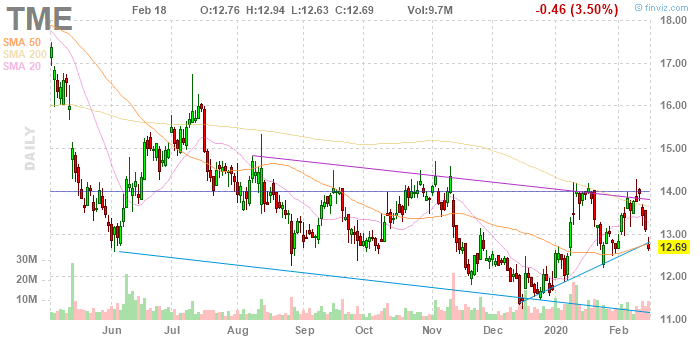U.S. stocks have held up reasonably well despite fears that the coronavirus from China may spread worldwide. Broad market indices did stumble on Tuesday as Apple (NASDAQ:AAPL) projected that it would miss guidance for its fiscal second quarter. But the equity market as a whole actually trades above where it did when coronavirus fears first came to the fore.
Perhaps more surprisingly, Chinese stocks actually haven’t fallen all that far. The iShares MSCI China ETF (NASDAQ:MCHI) did drop 11% in nine sessions starting on Jan. 17. The ETF has recaptured about two-thirds of those losses, however.
But with the new virus still spreading, it’s possible that selling pressure will return. Wednesday’s big stock charts focus on three of the country’s biggest names. All three charts suggest potential inflection points ahead regardless of how that country’s market performs going forward.
Alibaba (BABA)
Alibaba (NYSE:BABA) saw its rally interrupted by pandemic fears last month. And though BABA stock only is down about 4.6% from its highs, the first of Wednesday’s big stock charts does suggest a modest amount of near-term concern:
- Investors admittedly did buy the dip: BABA has bounced 10% from its January lows. The 50-day moving average since has provided support on multiple occasions. But it will need to do so again after the stock established a third lower high. More broadly, a developing wedge pattern suggests investors haven’t quite made up their minds, even as rival JD.com (NASDAQ:JD) has broken out to a new high.
- One cause for worry is that Alibaba stock likely has a catalyst problem. Fiscal third quarter earnings last week crushed Wall Street estimates. Yet investors shrugged; BABA stock actually declined 1.76% the day of the release. Alibaba did warn about the effect of the coronavirus on Q4 numbers, but investors almost certainly were expecting some level of short-term pressure on revenue and earnings.
- So BABA seems likely to be driven in the coming weeks by broader sentiment toward China. That in turn suggests that the recent rally likely is at least paused. And as seen last year, when trade war worries sent shares below $150, Alibaba stock, despite its impressive growth, can struggle when sentiment toward Chinese stocks turns south. Even BABA bulls might at least consider stepping back, and hope that negative sentiment provides another buying opportunity.
Tencent Music Entertainment (TME)
Since its 2018 initial public offering, Tencent Music Entertainment (NYSE:TME) stock hasn’t gotten off the ground. Shares have gained 8% so far in 2020 but touched an all-time low in December.
With a 3.5% decline on Wednesday, the second of our big stock charts also raises near-term concern:
- With the decline, it’s clear that TME stock has failed to breach resistance at $14 once again. There’s still a bit of an ascending triangle pattern, which generally leans bullish. But at this point, there’s little evidence on the chart to suggest that a breakout is on the way.
- The selling pressure since January is somewhat surprising since the new virus might actually be a good thing for Tencent Music’s near-term performance. As Barron’s detailed last week, homebound Chinese consumers might ramp their usage of TME’s platform. At the very least, one would think pandemic fears would have less of an impact on TME than other Chinese stocks, yet even in that context, resistance has been stiff and the sell-off in recent sessions steep.
- Tencent Music does have a chance to change investor minds when it reports fourth quarter and full-year 2019 results on Mar. 16. Until then, however, it’s tough to see much of a path to a rally.
Weibo (WB)
Social media platform Weibo (NASDAQ:WB) would seem like another beneficiary of the new virus. Yet its shares fell sharply on Tuesday, and in that context the third of Wednesday’s big stock charts shows support needs to hold:
- WB stock is challenging the support line of a wedge pattern, and potentially retesting support around $40 and $41 that held in November and January. Shares sit firmly in the middle of a downtrend that goes back to November, before the company’s third quarter earnings miss. The stock has fallen away from moving averages as well. The chart doesn’t yet show cause for panic, and it’s possible investors again step in above $40, but the near-term outlook does lean bearish.
- Fundamentally, the case does seem more attractive. A 15x forward price-to-earnings multiple prices in little in the way of growth. The so-called “Twitter (NYSE:TWTR) of China” has strong user numbers and room to expand beyond China’s borders. Majority owner Sina (NASDAQ:SINA) offers a potentially cheaper way to get exposure to the company’s opportunity.
- But again, the near-term outlook does look concerning ahead of a key earnings report next week. At the least, many investors in recent sessions have decided they’d rather not own WB stock into that earnings report. The question for Chinese stocks more broadly might be whether that reluctance spreads to the market as a whole.
As of this writing, Vince Martin has no positions in any securities mentioned.



